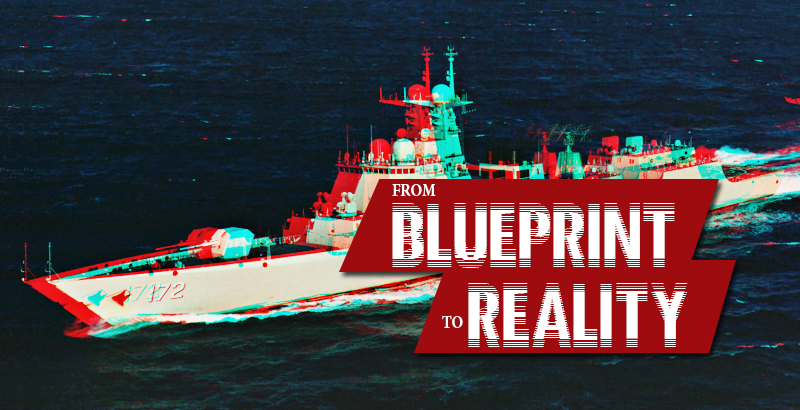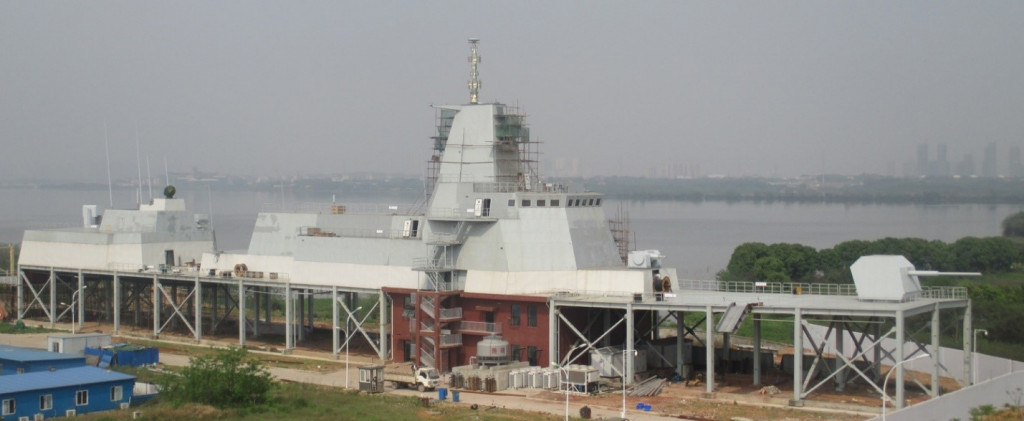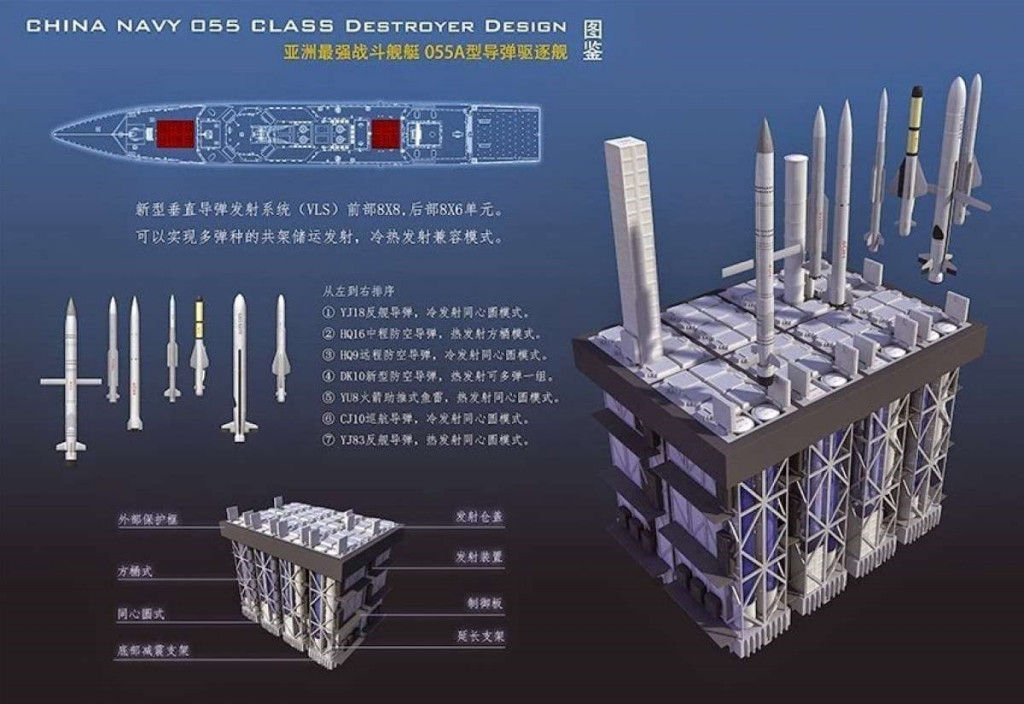
Written by Brian Kalman exclusively for SouthFront; Brian Kalman is a management professional in the marine transportation industry. He was an officer in the US Navy for eleven years. He currently resides and works in the Caribbean.
When the PLA Navy first eluded to its intention to build another class of guided missile destroyer (DDG) to follow the Type 052D, there was much speculation as to the dimensions, displacement, and intended role of such a vessel. In March of 2014, images began to circulate on the internet that clearly illustrated a test-bed mock-up of the new vessel’s superstructure at the PLA Navy’s testing center at Wuhan, in southern China. Military analysts and enthusiasts keep a watchful eye on the Wuhan facility, as mock-ups for China’s Liaoning CV-16 aircraft carrier, and now the follow-on CV-17 have provided a useful tool by which to extrapolate the eventual size and weapons and systems complement of the finished vessels. Comparing the Type 055 mock-up at Wuhan to the hull modules currently being constructed at the Jiangnan Shipyard in Shanghai, gives a relatively accurate estimation of total size and displacement.

Type 055 testing and training platform located at the Wuhan University of Science and Technology.
Initial estimates on size and displacement have narrowed as a result of new information and photographic evidence becoming available. Speculation of a displacement tonnage in excess of 14,000 tons and a Length Overall (LOA) of 187 meters have been revised down to a displacement of 12,000 tons at 180 meters LOA. This makes sense when one looks at the size of its most similar contemporary in the West, the Arleigh Burke class DDG. The latest Arleigh Burke Flight IIA weighs in at 9,200 tons, with an LOA of 155 meters. The proposed Flight III upgrade adds an estimated 600 tons displacement without any changes to LOA or beam dimensions.
Initial cost estimates for the first of the four planned Type 055 DDGs is in excess of $5 billion Yuan ($750 million USD). The GOA reported in 2016, that the per-unit cost of an Arleigh Burke Flight IIA is approximately $1.19 billion USD. If the Chinese estimate is correct, this denotes a significant cost savings per vessel for a platform that is at least as capable, if not superior to its U.S. counterpart in comparison. Its larger size suggests greater range, electrical power generation, and accommodation for both weapons, and sensory and electronic warfare systems than other DDGs in service.
Why Field a Larger DDG?
The PLAN has impressed both its admirers and detractors with the swift development and production of the Type 052D class DDG. The PLAN has built 12 of the vessels so far, with 4 already in active service. The remainder are in various stages of fitting-out or sea-trials. There is speculation that there may be an additional two units under construction at both the Dalian and Jiangnan shipyards. With the adoption of such a capable, high-tech DDG, why would the PLAN require an additional class of destroyer? There are a number of reasons why fielding the Type 055 alongside its smaller sibling makes perfect sense.
The Type 055 DDGs could serve in a multitude of roles. Similar to the U.S. Navy Ticonderoga Class CGs, they could offer longer range and greater Anti-submarine (ASW) and Anti-aircraft (AAW) defense for fleet task forces or aircraft carrier strike groups to be fielded by the PLAN in the near future. Type 052D and 055 destroyers could operate in conjunction with one another in a similar fashion as the Arleigh Burke DDG and Ticongeroda guided missile cruiser (CG), in providing a multilayered and robust fleet defense. With greater range and capability, they offer the PLAN the ability to increase the range and endurance of China’s naval power projection efforts, and further transform the PLAN into a true “Blue Water” navy. They will undoubtedly serve to showcase the growing military, political and economic power of China in broader diplomatic terms.
Current Construction Efforts
Two vessels have appeared in photographs and satellite imagery taken of the Jiangnan Shipyard. The hull of the first vessel in class is apparently completed. Two or three hull section modules of a second Type 055 can also clearly visible in satellite imagery of the shipyard, under construction alongside the lead-on vessel.

The above satellite image of Jiangnan shipyard dated November 11, 2016 clearly shows that the first Type 55 hull has been completed, while additional hull sections for a second Type 55 are under construction.
It turns out that a third Type 055 is under construction at the Dalian shipyard. Dalian is also currently building the CV-17 aircraft carrier, the first indigenously constructed aircraft carrier for the PLAN. Dalian has also been building the Type 052D class destroyers in conjunction with Jiangnan. Using both of the shipyards has allowed China to speed up its acquisition of these modern naval vessels.

This satellite image of Dalian shipyard captures what appears to be a third Type 055 DDG (top left) under construction. Image was taken November 20, 2016.
Capabilities
The Type 055 is being fitted with either two 64 cell modular vertical launch systems (VLS) or one 64 cell and one 48 cell VLS. One VLS is mounted forward in the bow of the destroyer, between the deck gun and the superstructure, and one VLS between the main superstructure and the aft helicopter hangar. The modular VLS will most likely be the same system currently utilized by the Type 052D, and will be able to house and fire all current missiles in the PLAN inventory, including the YJ-18 anti-ship cruise missile and HQ-9 anti-aircraft missile.

This unofficial artist’s rendition illustrates the modular nature of the PLAN VLS and its ability to be loaded with a mix of missiles. This allows the PLAN to equip its vessels with mission specific payloads. The red squares denote the approximate orientation of the two VLS on the Type 055.
The Type 055 mock-up at Wuhan gives clues as to the possible radar array planned for the vessel, as well as the electronic support measures (ESM) to be carried. It is assumed by most analysts that the Type 055 will make use of an updated Type 346A active phased array radar (APAR) as well an X-band radar. The Type 055 will most likely use 4 phased array radar panels, with two panels on the front of the superstructure and two aft. Where the Type 052 mounts four panels at the same height, both fore and aft, the Type 055 may align the panels at an offset height in an attempt to maximize radar coverage. The integrated mast on the Type 055 mock-up mounts 3 radar panels, most likely for friend-or-foe identification (IFF), fire-control and electronic countermeasures (ECM), on the forward face of the mast only, yet the actual vessels will carry these same panels on all four sides of the mast. The mock-up also sports an exposed ESM mast at the top of the integrated mast, but it is unclear whether the ESM mast will remain exposed or not on the actual vessel.

A comparison of the integrated mast structures of the Type 055 mock-up and the active Type 052D Kunming. Note the location of the forward two active phased array radar panels on the Kunming. The large sloped superstructure facing, just under the starboard side bridge deck portals on the Type 55, will be fitted with a similar APAR panel.

The above illustrations clearly show the similarities and differences in the Type 052D (top) and Type 055 (bottom) guided missile destroyers.
Commonality and Functionality
Sharing common weapons, radars, electronic warfare systems, and sonar and communications systems across both platforms will allow the PLAN to achieve a great deal of cost savings. Common battle management systems and networking platforms will allow the vessels to easily coordinate both offensive efforts and defensive measures when working together as components of a larger fleet. It will also lower training costs, as sailors and officers will be able to more easily transition to deployments on either class of vessel. It is estimated that the propulsion systems of the newer vessel are similar to the smaller Type 052D. The PLAN aims to leverage all of the benefits of standardization.
The United States Navy has embarked upon a very different path, and is already paying a heavy price for deciding to not only field a number of totally new vessel designs, but at the same time abandoning proven technologies for unproven ones. The Freedom and Independence LCS programs, the first in class Gerald Ford CVN, and the DDG-1000 Zumwalt destroyer project are all glaring examples.
Both class of LCS have experienced major engineering casualties since they were commissioned. Initial investigations have pointed to a combination of faulty engineering systems and inadequate engineering management processes. A major goal of the LCS program was to reduce vessel crews by automating as many processes as possible, and to gain flexibility through a modular design that allowed the platforms to be made mission specific by swapping warfare modules. For example, an LCS could be fitted with an ASW module to focus on anti-submarine duties one year, and then have the module removed and replaced with an AAW module the next, so that it could be shifted to air-defense duties as requirements changed. The benefits of this modularity have largely not been realized to date. For example, the LCS has failed to meet its intended ASW capabilities, even though the first vessels were commissioned in 2008 (Freedom LCS-1) and 2010 (Independence LCS-2).
The DDG-1000 Zumwalt was originally planned as the first of 32 vessels; however, the U.S. Navy later settled for only 3 vessels, as cost overruns and the failure of the design to meet mission requirements became evident. What resulted from the ambitious program are a $4 billion USD cost per vessel, advanced deck guns that are too expensive to use as intended (with an estimated cost per round of $800,000 USD), and an Advanced Induction Motor (AIM) propulsion system that left the Zumwalt dead in the water on its maiden trip through the Panama Canal on November 22, 2016. The DDG-1000 class are not Aegis vessels, have limited AAW capabilities due to their smaller missile payload, and lack any Ballistic Missile Defense (BMD) capability. They cannot integrate and coordinate AAW or BMD defense like all other Aegis class vessels. This is a major weakness, compared to all other Arleigh Burke and Ticonderoga class surface combatants, that can work together seamlessly using shared Aegis-based systems.
The most expensive naval vessel ever constructed, the Gerald R. Ford CVN-78, has already cost U.S. tax payers a cool $13 billion USD, yet the Navy Sea Systems Command (NAVSEA) has no idea when it will be able to officially take delivery of the vessel. Major defects in the main turbine generators (MITs), and an Advanced Arresting Gear (AAG) that has yet to be deemed operational, have only added costs to a program that has already experienced cost overruns approaching $3 billion USD. The adoption of multiple unproven technologies in the key areas of propulsion, and aircraft launch and recovery systems, was a foreseeable mistake.
Chinese Aircraft Carrier Strike Group Takes Shape
While the Type 055 DDG will undoubtedly add a key component to future PLAN aircraft carrier strike groups (CSG), replenishment and support vessels that have the speed and range to match the warships of a CSG are an additional requirement. Although not earning the spotlight afforded aircraft carriers or large destroyers, the Type 901 fleet replenishment oiler (although classified by the PLAN as a “general supply vessel”) is a noteworthy addition to China’s growing blue water navy. The first Type 901 began sea trials in December of 2016. Measuring in at 240 meters LOA, and displacing 48,000 tons, the Type 901 has five liquid bulk cargo tanks for fuel and potable water and two dry cargo holds. A maximum cruising speed of 25 knots has been reported. It is equipped with hangar space for three heavy helicopters, as well as a sizeable flight deck. The Type 901 is reported to utilize an automated logistics management system that tracks and optimizes fuel consumption and logistics replenishment needs of fleet vessels. A second Type 901 is currently under construction at the Guangzhou naval shipyard.

Type 901 undergoing sea trials in December, 2016. An additional vessel is currently under construction at the Guangzhou Shipyard International (GSI) naval shipyard.
The PLAN commissioned three new Type 903A fleet oilers in 2016 alone (numbers 887, 963, 964), and is showing a dedicated interest to expand its fleet refueling capabilities. Replacement of older vessels with new, more capable designs, and expanding the total number of oilers and replenishment vessels will expand China’s power projection capabilities. The Type 903A has an LOA of 178 meters and displacement of 23,400 tons. In addition to the Type 903A, two Type 904B dry cargo/general stores vessels were commissioned in 2015, with a third such vessel currently being fitted out. These vessels are ideally suited for supporting off-shore island garrisons, such as those being stationed on Chinese held islands in the South China Sea. All of the PLANs Type 904, Type 904A and Type 904B dry cargo replenishment vessels are attached to the South Sea Fleet based at Hainan Island. The Type 904 was increased in size with the Type 904A and the addition of a heavy helicopter hangar was added in the design of the Type 904B.

Type 903 fleet replenishment oiler (bottom) and Type 904 dry cargo/general stores support vessels.
2017: A Big Year for the PLAN
Although the CV-17 aircraft carrier will not be commissioned until 2018 or 2019, this year is shaping up to be a big year for the PLAN, considering the expansion of the navy in both quantitative and qualitative terms. In addition to the commissioning on three more Type 052D destroyers, three additional Type 054A frigates, two newly commissioned Type 056 corvettes, one Type 904B and one Type 901 large replenishment ship, the first of China’s largest and most capable surface warships, the first Type 055 will be launched. Although the Type 055 will not be a game changer, in that it does not afford China a distinct advantage over near-peer adversaries, it does level the playing field in China’s favor in any prospective conflict. In terms of regional adversaries, it gives China a powerful advantage over the small navies at its doorstep. Only Japan’s JMSDF and the United States Navy in the Pacific region will maintain an edge over an increasingly capable and assertive PLAN. As time goes on, this advantage in naval power will continue to diminish.





